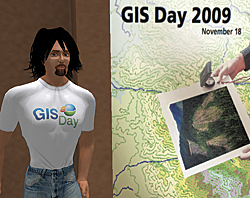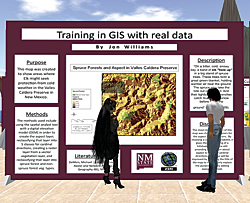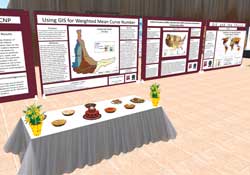ArcUser Online
Aggie Island, as this virtual environment is known, is owned and maintained by the university's College of Extended Learning and Information and Communications Technologies. As part of the author's Geography 481 class, which teaches the fundamentals of GIS, 15 students voluntarily created virtual posters that demonstrated their GIS accomplishments. These students received official Esri Certificates of Participation that are displayed on the backs of their posters. The display opened on GIS Day (November 18, 2009) and has been kept up to encourage GIS education and the use of virtual worlds, such as Second Life, for learning, exposition, and collaboration. The event, staged in the center of Aggie Island, resembled a scaled-down, virtual version of a poster session at the Esri International User Conference. As with real-world poster sessions, there was food (all digital and calorie free), beverages (including virtual champagne), free goodies (such as virtual GIS Day ball caps and T-shirts), and lots of information about GIS and how it is used. A small movie theater showed a YouTube video that introduced GIS to visitors who were new to the topic. Student volunteer avatars provided attendees with directions and encouragement. These avatar students also staffed an information desk that provided materials about the GIS courses available from NMSU as well as information about the National Geography Awareness Week event that was taking place on campus concurrently with the GIS Day events in Second Life.
Since it opened, the virtual GIS Day display on Aggie Island has received nearly 100 avatar visitors from different parts of the United States and abroad—many more attendees than could be expected from a one-day, real-world event held in a small venue. However, the advantages of having such an event in a virtual world go beyond just the number of attendees. First, a virtual event minimizes cost. Printing an average poster costs between $30 and $100. If the current poster display was created in the real world, it would cost at least $450 and possibly as much as $1,500. Posters and certificates for the event cost the author a grand total of $300—in Linden dollars, the currency of Second Life. At the current U.S.-Linden dollar exchange rate, the cost was approximately $1.25. Second, setting up a real poster display typically involves renting display boards and space, physically moving the displays and tables around, and setting up the posters themselves. Besides the hours involved, the cost is sometimes prohibitive if there are many attendees.
Perhaps the most important advantage of a virtual GIS Day event is that the entire display—including the structures—is portable. It can all be moved to a different location, such as a traveling display. The Aggie Island display will be part of an Esri-sponsored event at the March Microcomputers in Education Conference in Tempe, Arizona. This is similar to the high school lyceums that were popular years ago, but without the expense. This would be an effective and inexpensive way to get the word out to more potential GIS users. In fact, Linden Laboratories, the owners of Second Life, also have a Teen Grid that allows secondary teachers to have GIS poster sessions for their classes. The possibilities, to steal words from Esri president Jack Dangermond, ". . . are limited only by your imagination." For the immediate future, the NMSU GIS Day poster display can be accessed in Second Life using the following landmark: AggieLand Public, NMSU Aggie Island (133, 76, 26). For more information, contact the author's avatar, Gadget Loon, in Second Life through instant messaging or directly (in the nonvirtual world) at Michael N. DeMers About the AuthorDeMers is the author of another article on this topic, "Inside the Metaverse: A 'Second Life' for GIS Education," which appears in the Winter 2009 issue of ArcUser. |


